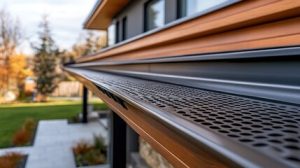A well-chosen fence can elevate privacy and security while transforming your outdoor space into a personal retreat. It can also boost the curb appeal of your property. Fences are available in a wide range of styles and materials. Wood fences offer classic appeal, while vinyl provides a low-maintenance alternative. Aluminum and wrought iron fences offer durability and elegance. Contact All American Gutters and Fences for professional help.

Whether you’re looking to add an eye-catching design feature or simply define your property lines, split rail fences are a beautiful and functional option. They come in two-, three-, and four-rail options and can be made from a variety of woods, including Western red cedar. These traditional fencing solutions offer a classic, rustic look that pays homage to rural living’s hallowed roots. They are also durable enough to contain animals and serve as a deterrent against trespassers. Additionally, these fences can be integrated with wire mesh to increase their functionality and longevity.
Split rail fences are a popular choice among ranches and farms because of their versatility, durability, and affordable price tag. They are often crafted from wood, which blends seamlessly into natural surroundings and complements many architectural styles. They are also ideal for defining and securing property boundaries and can be used to enclose gardens or pastures. Additionally, split rail fences can be easily adjusted to accommodate changing landscapes.
A split rail fence can be a great choice for homeowners who want to prevent flooding, as they are highly resilient and easy to maintain. These fences have a minimal number of parts, which makes them more durable than other types of fencing. They can withstand flood conditions and other environmental hazards, such as extreme heat and cold. In addition, they can be rolled up or taken down quickly to prevent flood damage and minimize the risk of costly repairs.
If you have a split rail fence, it’s important to maintain it regularly. You can do this by staining or painting it every few years to protect the wood from weathering and deterioration. You should also regularly walk your fence line to check for damaged posts and rails, and promptly make any needed repairs.
A split rail fence can be a wonderful addition to your home, as it will enhance the aesthetic of your property and increase its value. In addition, it will help prevent flooding by clearly defining your property lines. It will also keep pets and children safe from intruders, making it an excellent deterrent against trespassing.
Picket fences
The classic picket fence is a symbol of middle class life in America. Its clean lines and simple design complement many different architectural styles, making it a popular choice for homeowners. But picket fences also come with a number of disadvantages, including privacy and security concerns. By understanding these issues, homeowners can make the best decision about which type of fence is right for their homes.
A picket fence is a traditional style that’s often used in the front yards of homes, but it can also be used for other purposes, such as protecting gardens or keeping pets out of the yard. Its origin dates back to colonial America, where it was originally used to keep livestock out of gardens and mark property boundaries. It later evolved into a cultural icon of American suburban living. Today, the iconic white picket fence is a familiar sight on neighborhood streets and in immaculately manicured lawns.
One of the most important things to consider when choosing a fence is whether it can protect your home from flooding. A premium metal fence is an excellent choice for flood prevention because it can easily be repositioned when the water recedes. Moreover, it is made of high-quality materials that can withstand heavy rains. This makes it a smart option for anyone who lives in a flood-prone area.
In addition to its ability to prevent flooding, a premium metal fence is also durable and easy to maintain. It can be easily repainted to match the style of your home and is resistant to weathering. It’s a good idea to choose a fence that is built using galvanized materials and rust-proof fasteners to ensure that it won’t rust or be damaged by rain and wind.
Another problem with traditional wood fences is that they are susceptible to water damage. Rain exposes the wood to moisture, which can cause it to rot or develop mildew. This can lead to a variety of problems, including holes in the fence. To avoid this, you can use a gutter system to divert the water away from your fence and onto the ground.
Privacy fences
Many homeowners want their outdoor spaces to feel like a private sanctuary, and privacy fences offer several benefits to help make that happen. They block prying eyes from neighbors and passersby and can help keep people and animals from encroaching on the property. They also create clear boundaries for pools, hot tubs, and other amenities and can prevent children or pets from escaping the yard. Additionally, they provide a degree of security that can help deter burglars.
Privacy fences come in a wide range of styles and materials, making it easy to find the perfect match for your home. Wood privacy fences, for example, can be built from a variety of species, including cedar and redwood. These types of wood are highly durable and stand up to inclement weather. They are also attractive and require less maintenance than other varieties of fencing. Vinyl privacy fences, on the other hand, are a good choice for those who want a low-maintenance option that is also affordable and available in a variety of colors.
When choosing a privacy fence, it is important to consider your local zoning regulations and homeowner’s association guidelines. These may have restrictions on the height, materials used, and more. Additionally, you should check with your local city hall to see if you need a permit to build your fence. If you do, you should allow plenty of time for the application process and ensure that all requirements are met before starting construction.
Once the fence is installed, it’s important to inspect it regularly for damage or wear and tear. Look for things such as splinters, loose boards, and cracks in posts and rails. Regular inspections will also help you identify areas that need repair or attention. If you do notice any issues, it is a good idea to contact a professional right away to avoid problems in the future.
A privacy fence can add a great deal of value to your property and enhance the curb appeal of your home. However, if you choose the wrong type of fence, it can be difficult to maintain and might not last as long as you expect. To get the most out of your fence, follow these tips to keep it looking new:
Security fences
A security fence not only defines property boundaries, but it can also serve as a deterrent to potential intruders. It can be made of a variety of materials, including wood, metal, and vinyl. Each has its own unique strengths and weaknesses in the face of extreme weather conditions such as hurricanes. For example, wooden fences require special preparation to withstand such conditions. Metal fences, on the other hand, can be highly durable but need proper installation and maintenance to withstand the force of winds. Vinyl fencing offers the advantage of being less expensive and easier to maintain, but it may not be as strong as other types.
To prevent flooding, it’s important to choose a fence with a solid base and high walls. In addition, it’s essential to install drainage systems that prevent water from pooling around the fence. This will help avoid soil erosion and structural damage. Another way to mitigate these problems is to regularly inspect the fence and make any necessary repairs.
Inspect for signs of rot and mold, which can cause damage and weakening of the structure. Consider using sealants to protect against moisture and insect infestations. Inspect the structure after severe storms to identify any weak points and repair them as soon as possible.
Lastly, installing a motion-activated lighting system will deter criminals and burglars by illuminating the area and giving the impression that someone is home. In addition to enhancing security, these lights can also be used to monitor your home and notify you of any suspicious activity.
Steel security fences offer superior strength and durability and can be designed in a variety of styles to suit modern or traditional aesthetics. They are ideal for use in areas where security is a top priority, such as correctional facilities and military bases. The strong construction makes it difficult to cut or bend the steel bars. The height and thickness of these fences is also a deterrent to intruders. These fences are typically installed in conjunction with other types of security fencing for increased safety and protection. They are often equipped with sensors that monitor movement and can detect any unusual activity.



